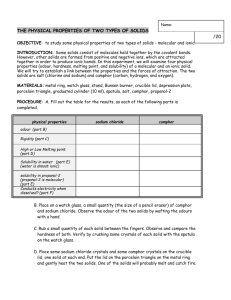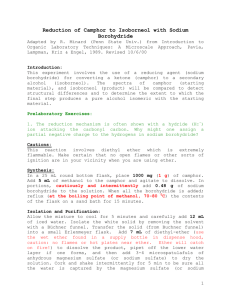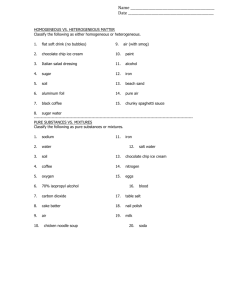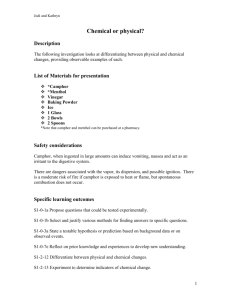B.Sc. SEM V - DAV College Jalandhar
advertisement
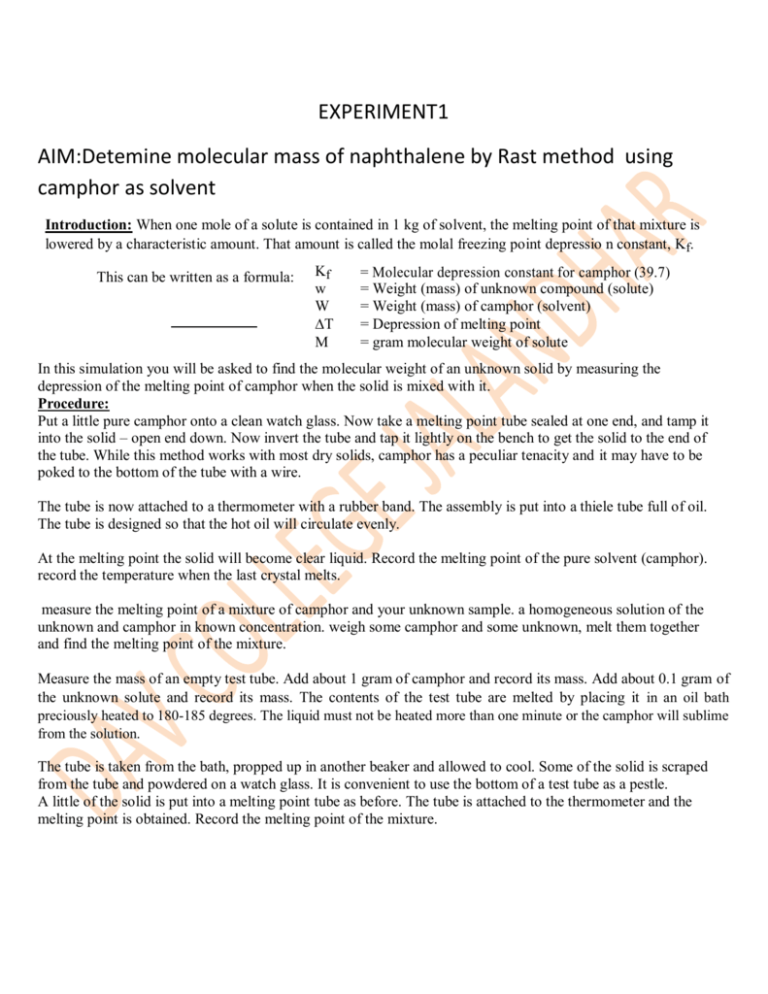
EXPERIMENT1 AIM:Detemine molecular mass of naphthalene by Rast method using camphor as solvent Introduction: When one mole of a solute is contained in 1 kg of solvent, the melting point of that mixture is lowered by a characteristic amount. That amount is called the molal freezing point depressio n constant, Kf. This can be written as a formula: Kf w W T M = Molecular depression constant for camphor (39.7) = Weight (mass) of unknown compound (solute) = Weight (mass) of camphor (solvent) = Depression of melting point = gram molecular weight of solute In this simulation you will be asked to find the molecular weight of an unknown solid by measuring the depression of the melting point of camphor when the solid is mixed with it. Procedure: Put a little pure camphor onto a clean watch glass. Now take a melting point tube sealed at one end, and tamp it into the solid – open end down. Now invert the tube and tap it lightly on the bench to get the solid to the end of the tube. While this method works with most dry solids, camphor has a peculiar tenacity and it may have to be poked to the bottom of the tube with a wire. The tube is now attached to a thermometer with a rubber band. The assembly is put into a thiele tube full of oil. The tube is designed so that the hot oil will circulate evenly. At the melting point the solid will become clear liquid. Record the melting point of the pure solvent (camphor). record the temperature when the last crystal melts. measure the melting point of a mixture of camphor and your unknown sample. a homogeneous solution of the unknown and camphor in known concentration. weigh some camphor and some unknown, melt them together and find the melting point of the mixture. Measure the mass of an empty test tube. Add about 1 gram of camphor and record its mass. Add about 0.1 gram of the unknown solute and record its mass. The contents of the test tube are melted by placing it in an oil bath preciously heated to 180-185 degrees. The liquid must not be heated more than one minute or the camphor will sublime from the solution. The tube is taken from the bath, propped up in another beaker and allowed to cool. Some of the solid is scraped from the tube and powdered on a watch glass. It is convenient to use the bottom of a test tube as a pestle. A little of the solid is put into a melting point tube as before. The tube is attached to the thermometer and the melting point is obtained. Record the melting point of the mixture. Data: Melting Point of pure camphor: T1 Melting Point of mixture: T2 Depression in freezing point T=T2-T1 Mass of empty test tube: _______ Mass of t.t. + camphor: _______ Mass of t.t. + camphor + unknown: _______ Calculations: Weight of camphor, W, = Weight of unknown, w, = _______ _______ K f w 1000 T W M EXPERIMENT 2 Aim- To Prepare Coppertetraamine complex [Cu(NH3)4]SO4.H2O. Theory- Tetraamine complex is prepared by the action of ammonia on copper suplahte. Requiremants- Copper sulphate=5g Concentrated ammonia=10ml Ethyl alcohol= 15ml Procedure1. Take 5g of finely powdered Copper sulphate and dissolve in minimum amount of water in a 200ml beaker. Add Few drops of dil.H2SO4 to get a clear solution\ 2. Add 10ml of concentrated ammonia solution to copper sulphate solution slowly with constant stirring until the blue ppt.of Cupric hydroxide initially formed dissolve to give a deep blue solution having ammonical smell. 3. Add 15ml of ethyl alcohol slowly to the beaker with constant stirring so that blue colour is discharged and the purple coloured ppt of tetraamine copper(II) sulphate separates out. 4. Heat the reaction mixture to 60-700C on a water bath for 10-15min. 5. Allow the solution to cool. Needle shaped blue coloured crystals of tetraammine copper(II) sulphate separates out. 6. Decant off the supernatant liquid. 7. Separate the crystals of filtration on an Buchner funnel under sunction. Wash the crystals with ethyl alcohol. 8. Remove the filter paper alongwith crystals from the Buchner funnel and place it on the folda of the filter paper. 9. Dry the crystals in the folds of filter paper and record the yield. Result- Deep blue in colour and needle shaped crystals are formed. Expected yield-5g. EXPERIMENT 3 Aim- To prepare Sodium trioxalatoferrate (III) Na3[Fe(C2O4)3].9H2O Theory- Sodium trioxalatoferrate (III) is prepared by the action of sodium oxalate on hydrated ferric oxide ( Fe2O3.3H2O) which is prepared by the reaction of ferric chloride with sodium hydroxide. Requirements- Ferric chloride =10.0g Sodium hydroxide=11.5g Oxalic acid= 12.0g Procedure1. Dissolve 10.0g of ferric chloride in 50ml of water. 2. Dissolve 7.5g of sodium hydroxide in 50ml of water. 3. Add Sodium hydroxide to ferric chloride solution in small lots with stirring to get precipitate of ferric hydroxide. 4. Allow the precipitate to stand and settle down. 5. Filter through a Buchner and wash the ppt. with hot water. 6. Dissolve 12g of oxalic acid in 50ml of water in beaker and it to 4g of sodium hydroxide pellets to get sodium oxalate solution. 7. Add ferric hydroxide ppt. to hot sodium oxalate solution with stirring. 8. Filter the solution to remove any insoluble impurities. Collect the filtrate in a china dish. 9. Heat the solution and concentrate it to the crystallization point. 10. Allow the concentrated solution to cool slowly and green coloured are obtained. 11. Wash the crystals with cold water and then with ethyl alcohol. 12. Dry the crystals and note the weight. Result The green coloured ppt are obtained and expected yield=15g EXPERIMENT 4 AIM: Determination of the strength of a solution of hydrochloric acid by a standard solution of sodium hydroxide conductometrically Theory: When hydrochloric acid solution (HCl) is titrated with sodium hydroxide solution ° + –1 –1 (NaOH), the highly mobile hydrogen ions ( H = 350 ohm cm ) are progressively ° + –1 –1 replaced by slower moving sodium ions ( Na = 50 ohm cm ) and the conductance of the solution decreases. After the end point, the conductance of the solution rises sharply due ° – –1 –1 to the presence of excess, highly mobile hydroxide ion ( OH = 198 ohm cm ). Thus the neutralization of a strong acid by addition of a strong base leads to a minimum conductance + at the end points. This is due to the disappearance of H ions and their + replacement by slower moving Na ions of the base followed by the presence of highly – mobile OH ions after the end point. Therefore the nature of the plot (conductance of the solution versus volume of base added) will be as given below: Figure 1 The conductivity cell used for this titration should permit stirring by shaking and to which the reagent can be added from burette. A large increase in volume during titration should be avoided. Apparatus: Conductometer, conductivity cell, beaker, pipette, burette, conical flask. Chemicals: Hydrochloric acid (HCl), sodium hydroxide (NaOH), conductivity water. Procedure: 1. HCl solution of unknown strength is provided. 2. 0.1 (N) NaOH solution is provided. 3. Calibration of the instrument done at room temperature. 4. Conductometric Titration: i) Rinse the conductivity cell a number of times with conductivity water or double distilled water. ii) Pipette out 20 mL of HCl in a beaker and dip the conductivity cell in it, so that the cell should dip completely in solution. iii) Note the temperature of the sample solution and accordingly set the temperature control or keep the cell in a thermostat at room temperature. iv) Add NaOH solution (few drops) from burette into HCl in lots of 0.5 ml,after each addition stir it and measure the conductance after each addition. v) Note the conductance till 10 ml of NaOH solution has been added Observation and Calculation: Table 1:- Conductometric Titration s.no 1 2 3 4 5 6 7 8 9 10 11 12 13 14 15 16 17 18 Volume of 0.1 N NaOH added(ml) 0.0 0.50 1.00 1.50 2.00 2.50 3.00 3.50 4.00 4.50 5.00 5.50 6.00 6.50 7.00 7.50 8.00 8.50 conductance Plot a graph between conductance and volume of titrant (NaOH solution). Two intersecting lines will be obtained (as given in the Figure 1) and the points of intersection of these lines represent the equivalent point. Let, V2 be the volume of NaOH at the equivalent point (from graph) for 20 ml 0.1 NHCl Then (HCl) N1 V1 = N2V2(NaOH) N1 = ()V2/200 (N) Strength= normality × equivalent bond = (V2/200) × 36.5 g/L Precautions: i) Electrical connection should be made carefully. ii) Temperature during the experiment should be kept constant as conductance depends on temperature. iii) Stirring should be done after each addition of titrant. iv) To avoid the dilution effect, the concentration of the titrant should be 5-10 times more than that of the solution to be titrated. EXPERIMENT 5 AIM:To find refractive index of the given liquid samples and find Molar refraction and specific refraction. APPARATUS:Abbe’s source and samples. refractometer, temperature controller, light THEORY: Abbe’s Refractometer:The Abbe instrument is the most convenient and widely used refractometer, Fig(1) shows a schematic diagram of its optical system. The sample is contained as a thin layer (~0.1mm) between two prisms. The upper prism is firmly mounted on a bearing that allows its rotation by means of the side arm shown in dotted lines. The lower prism is hinged to the upper to permit separation for cleaning and for introduction of the sample. The lower prism face is rough-ground: when light is reflected into the prism, this surface effectively becomes the source for an infinite number of rays that pass through the sample at all angels. The radiation is refracted at the interface of the sample and the smooth-ground face of the upper prism. After this it passes into the fixed telescope. Two Amici prisms that can be rotated with respect to another serve to collect the divergent critical angle rays of different colors into a single white beam, that corresponds in path to that of the sodium D ray. The eyepiece of the telescope is provided with crosshairs: in making a measurement, the prism angle is changed until the light-dark interface just coincides with the crosshairs. The position of the prism is then established from the fixed scale (which is normally graduates in units of nD). Thermosetting is accomplished by circulation of water through the jackets surrounding the prism. The refractive index of a substance is ordinarily determined by measuring the change in direction of colliminated radiation as it passes from one medium to another. (1) Where v1 is the velocity of propagation in the less dense medium M1 and v2 is the velocity in medium M2; n1 and n2 are the corresponding refractive indices and θ1 and θ2 are the angles of incidence and refraction, respectively Fig 2. When M1 is a vacuum, n1 is unity because v1 becomes equal to c in equation (1). Thus, (2) Where nvac is the absolute refractive index of M2. Thus nvac can be obtained by measuring the two angles θ1 and θ2Abbe's refractometer is used to measure the refractive index of the given organic liquid. Using a particular monochromatic light source, the apparatus is calibrated with water as the liquid. Adjust the micrometer screw to focus the boundary between the bright and dark regions. Adjust the refractometer scale to place the cross wire of the telescope exactly on the boundary between the bright and dark regions. Repeat the same process for different organic liquids after the equipment is calibrated. PROCEDURE: 1. Clean the surface of prism first with alcohol and then with avetone using cotton and allow it to dry. 2. Using a dropper put 2-3 drops of given liquid b/w prisms and press them together 3. Allow the light to fall on mirror. 4. Adjust the mirror to reflect maximum light into the prism box 5. Rotate the prism box by moving lever until the boundary b/w shaded and bright parts appear in the field of view. 6. If a band of colors appear in the light shade boundary make it sharp by rotating the compensator. 7. Adjust the lever so that light shade boundary passes exactly through the centre of cross wire 8. Read the refractive index directly on the scale 9. Take 3 set of readings and find the average of all the readings. OBSERVATIONS: Room temp. =_degrees Sr.No. LIQUID 1. 2. 3. REFRACTIVE INDEX i Specific refraction, R = (n2 _ 1)/(n2 + 2) × 1/d Molar refraction, Rm= R ×M( molecular mass of liquid)

